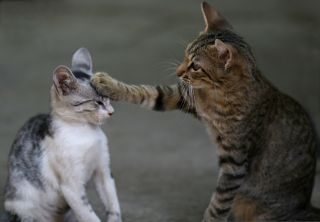Anger
How to Tell if Cats Are Playing or Fighting
The key role of vocalisations in agonistic interactions.
Posted February 27, 2023 Reviewed by Devon Frye
Key points
- A new study of cat behavior concludes that if cats are quietly wrestling, they're most likely playing.
- If cats are vocalizing and chasing one another, it's most likely fighting.
- If they're vocalizing, chasing, and resting, they're likely assessing what's happening and deciding whether to continue or to stop.
- When we know what cats are doing, we can give them more freedom to romp around with friends, avoid foes, and feel comfortable that all is OK.

I'm pretty good at reading dogs and figuring out if they're playing, fighting, or in some grey area where the encounter can go either way. I'm not as sure about cats, although "cat people" are likely better than I am about making this determination.
So I was pleased to see an open-access paper by Dr. N. Gajdoš-Kmecová and her colleagues called "An ethological analysis of close-contact inter-cat interactions determining if cats are playing, fighting, or something in between" that focused on distinguishing vigorous rough-and-tumble play from real aggression.1 (The phrase "agonistic behavior," or simply "agonism," is often used to include threatening, fighting, and submitting.) I also wondered if cats, like dogs, follow what I call the "golden rules" of play and like to engage in frenetic zoomies.
To learn more about what is happening when cats play, fight, or occupy some blurry middle ground that could go either way, the researchers analyzed videos of 105 interactions that occurred when pairs of cats were socially interacting (210 cats were studied). They also developed an ethogram—basically a menu of various overt actions that the cats performed.
The ethogram was broken down into six categories:
- Inactive body posture: The head and torso of the cat are motionless and in a specific position (e.g. crouching, lying, sitting, standing, rear).
- Wrestling: The cat engages in physical contact with another cat, whereby the focal cat appears to struggle with the other cat. This can include pulling the cat toward itself with its forelegs and performing raking movements with the hind legs (e.g. reversed wrestling, reversed half-wrestling, parallel wrestling, parallel half-wrestling; within wrestling: foreleg movements, bites, snap bites, non-injurious biting, rake, kick).
- Chasing: Cat runs rapidly in pursuit of another cat or the cat runs away from another cat (flee) or one cat travels closely behind a cat (follow).
- Other interactive activities: Activity of cat directed towards another cat (e.g. allogroom, approach, arch back, avoid, belly-up, displace, face-off, foreleg movements directed towards another cat, horizontal leap, lordosis, mount/clasping, neck flex, piloerection, pounce, retreat, side step, sniff another cat, stand up, stalk, vertical stance, roll on back).
- Non-interactive activities: Activity of a cat directed towards itself or an inanimate object. (e.g. manipulate object, drink, head shake, jump, self-lick, run, trot, walk).
- Vocalisation: The cat produces sounds or calls, originating from the throat and mouth (e.g. growl, hiss, snarl, spit, yowl, mew, gurgle).
Using a statistical method called Principal Components Analysis (PCA), the researchers wanted to determine what behaviors were observed during playing, fighting, or in the middle ground. PCA basically allows researchers to determine which factors—in this case, which actions—are most important in the different contexts in which they are observed.
What Do Cats Do When Playing vs. Fighting?
The researchers write, "The results of this study suggest [a] distinction of three types of close animated inter-cat interactions: playful, agonistic, and an intermediate form involving elements of playful wrestling, but also the vocalisation and chasing typical for agonistic interactions." Importantly, they note that looking at cat-cat interactions as either playful or agonistic is misleading, because there are shades of grey when cats encounter one another.
A useful guide as to which behaviors can be used to determine what cats are doing is:
- When cats were playing, something that was observed in 40 percent of the videos, they wrestled and didn't vocalize.
- The most distinctive of the different categories was agonistic behavior which was observed in 32 percent of the cats, during which they vocalized, chased one another, and had periods of rest. Vocalizations were the most important behaviors separating play from fighting. If chasing was mutual, it was more likely play. When the cats were resting, they may have been deciding what to do next based on what previously happened, what the other cat was doing, and what they, themselves, wanted to do.
- When the cats were in the murky middle, where 28 percent of the cats were observed, their behavior was more playful than agonistic. Of course, play could escalate into aggression depending on what each cat wanted to do. The researchers didn't report how often this occurred, but in dogs, it is extremely rare.
Where to Go From Here
This is the first ethological study of playing and fighting in cats in domestic settings and I found it to be an extremely valuable guide. I'd like to see more studies like this in other animals, especially those who are common household companions, who need all the freedom they can get to play and socially interact. Because social relationships can change over time, knowing the nitty-gritty details is very useful for being as permissive and as least restricting and "helicoptering" as possible.2
When we know what separates playing from fighting, we can give cats and other animals more freedom to romp around with friends, avoid foes, and feel comfortable that all is and will be OK.
Facebook image: schankz/Shutterstock
References
1) An excellent summary can be found in "Are your cats fighting or playing? Scientists analysed cat videos to figure out the difference".
2) See "For Dogs, Helicopter Humans Don't Balance Scolds and Praise" for how skewed dog-human relationships can be. Preliminary data show we say "no" or "don't" far more than "yes" or "good dog."


